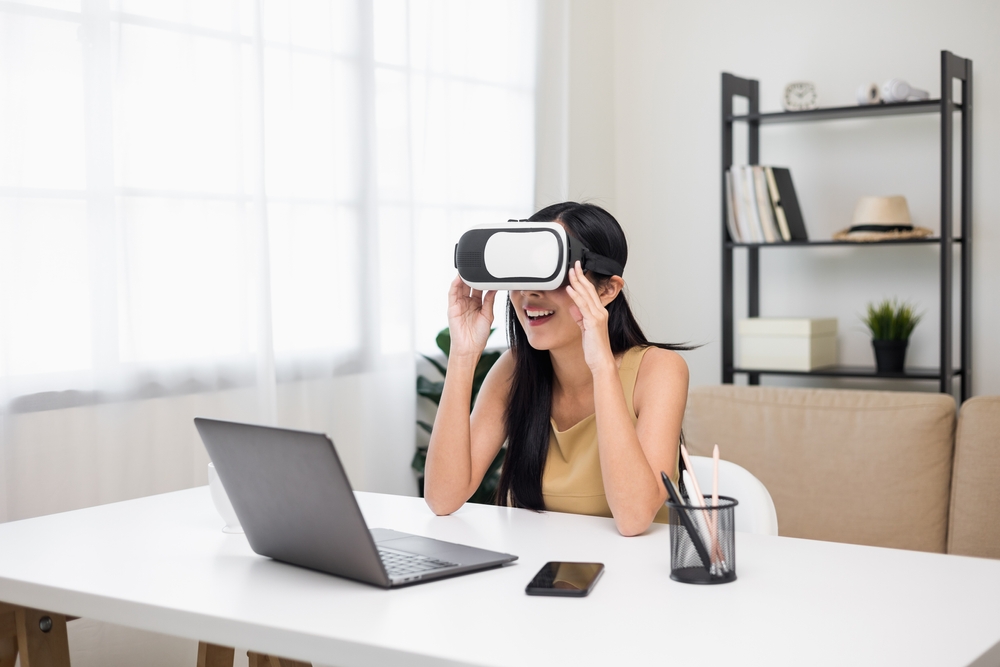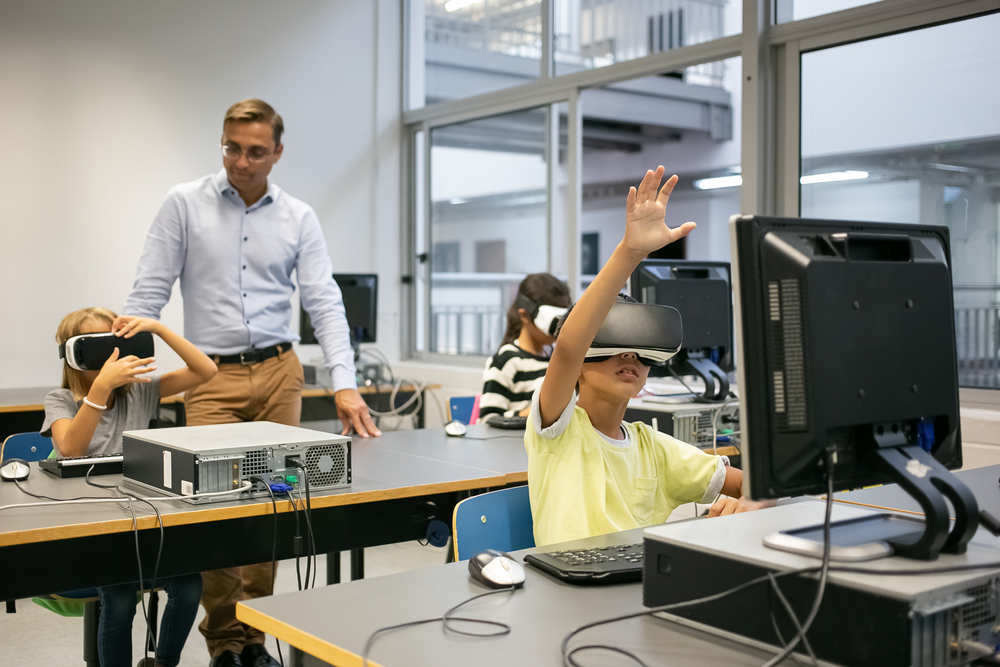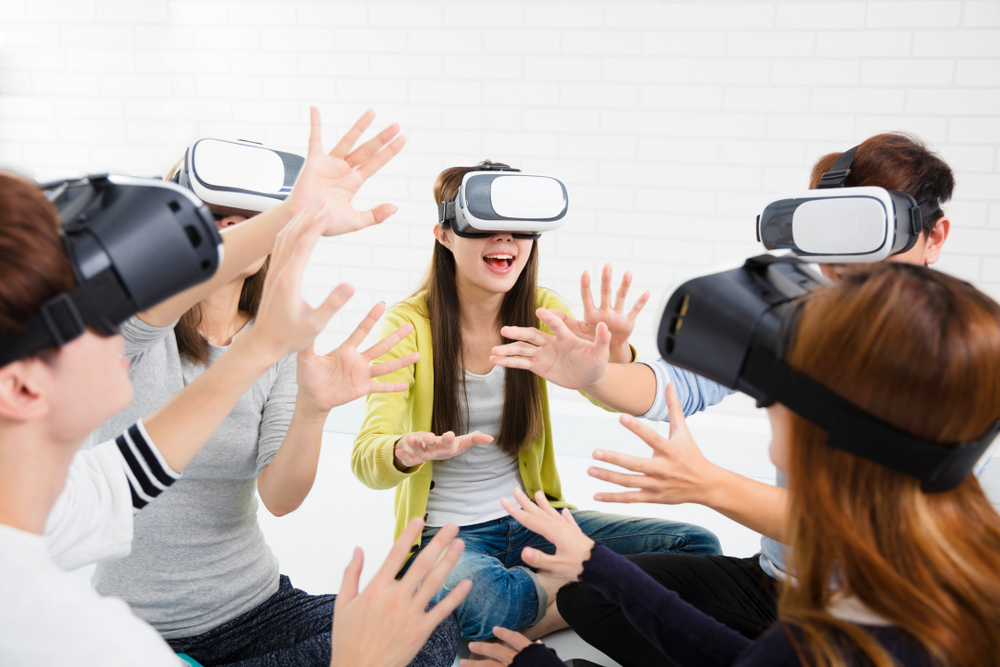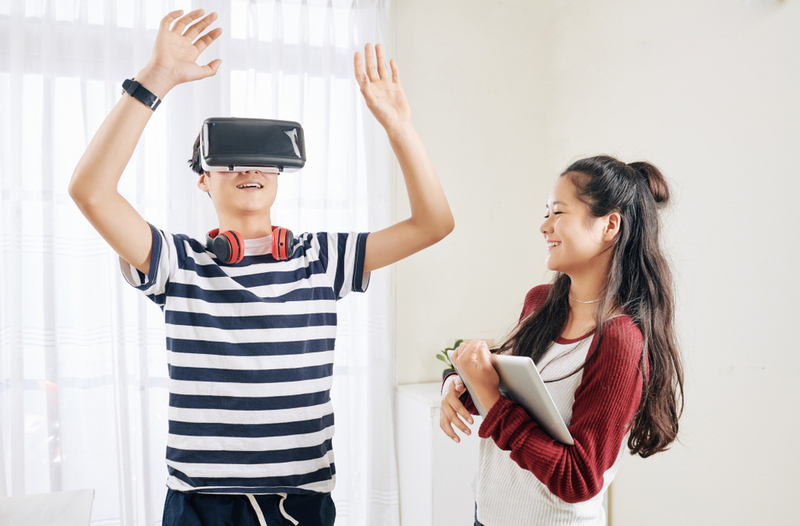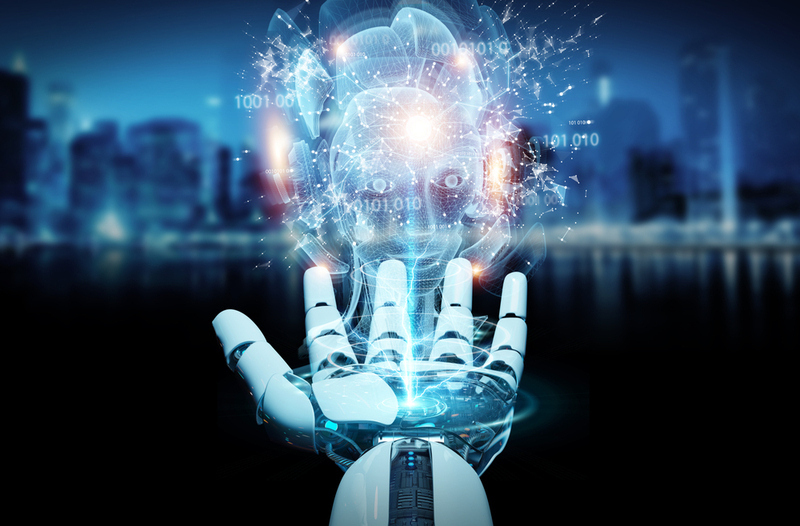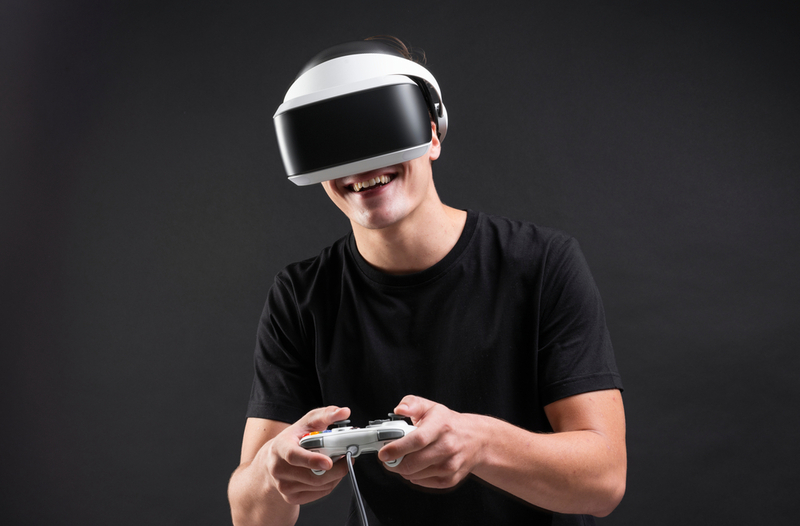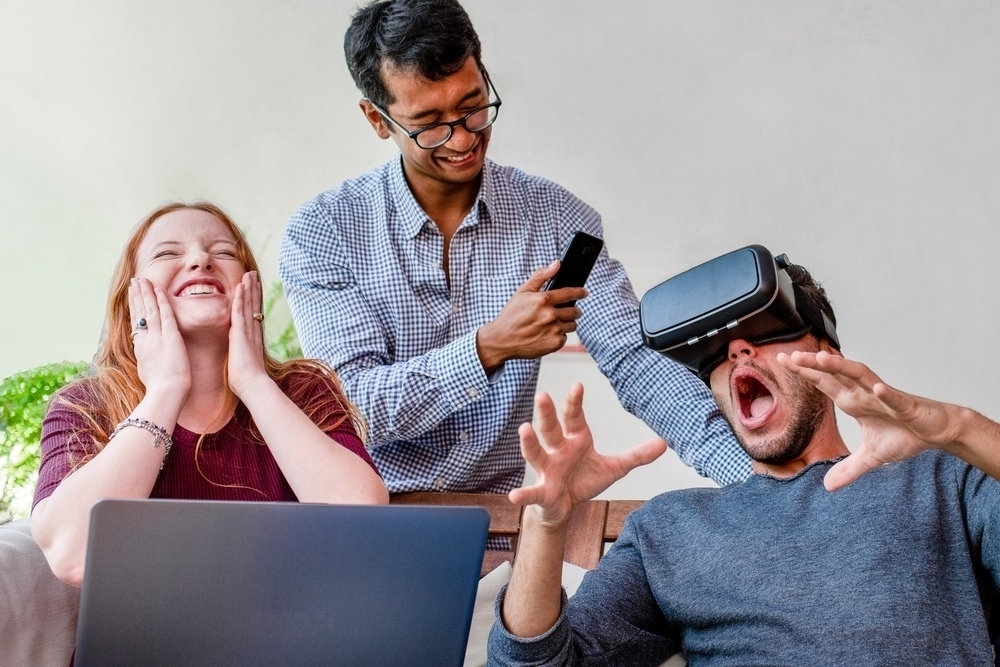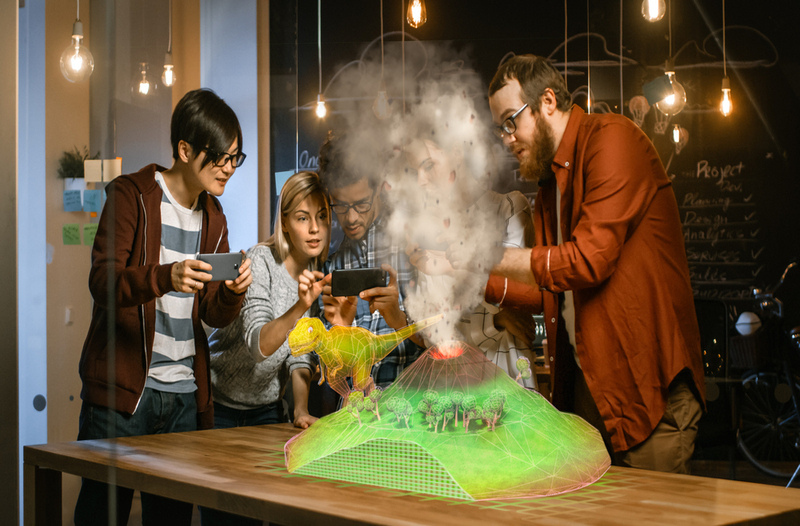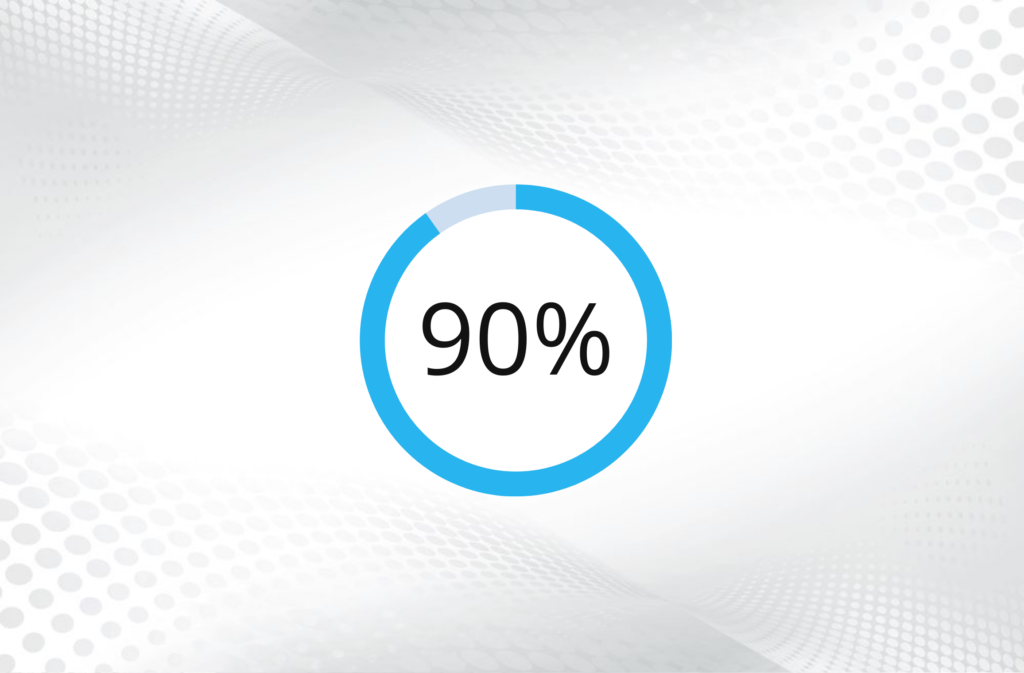Mixed reality
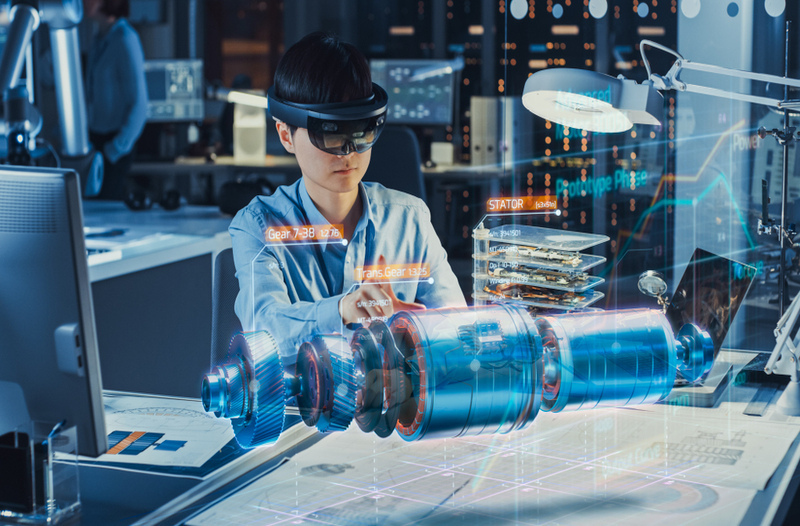
Mixed reality
The next decade of technological advances will see more and more of the human experience transition into the digital realm. Exponential developments in computing are continuing to enhance efficiency in all aspects of our lives, whether at home or at work, and digital reality technologies like virtual reality (VR), augmented reality (AR), and mixed reality (MR) are increasingly taking centre stage.
Although the initial use case for digital reality tech has been entertainment, in recent years more and more professional applications for VR, AR, and MR have emerged in areas like product design, architecture, manufacturing, retail, and education. As John Egan, CEO of L’Atelier, a foresight company that is part of the French banking giant BNP Paribas, says: “By the 2030s, tech will facilitate a new digital infrastructure that sits on top of the physical infrastructure, one that will be unique to individuals through AR glassware and eventually through contact lenses and even neural implants.”
Digital reality technology is really an umbrella term that encompasses immersive, deeply engaging, and multi-sensory technologies like virtual reality (VR), augmented reality (AR), and mixed reality (MR). Digital reality technologies make use of computer-generated content to create fully virtual or digitally-enhanced environments that can help foster a new kind of understanding of, and relationship with, your surroundings and the objects and people within them. Let’s explore the three most well-known ones in more detail.
Virtual reality (VR)
Virtual reality is a fully immersive, computer-generated simulation with scenes, sounds, and objects that can almost appear to be real. A person can interact with the objects in this simulated environment and have a very realistic experience. The simulated environment can be experienced through the use of special electronic equipment, such as a headset with a screen, headphones, and special gloves with haptic feedback technology.
In this simulated world, users can immerse themselves as if they were one of the characters (in the case of a VR game), and look all around them as if they were actually physically there. VR tech has come a long way since its humble beginnings, however, and you can now get headsets, aided by computer systems, that enable you to play ‘real’ sports in your living room or even learn how to perform open heart surgery.
While all of this may sound rather futuristic, the origins of VR actually date back to the mid-50s. The ‘Experience Theatre’ Sensorama, for instance, was a mechanical device that included a stereoscopic colour display, stereo-sound system, a motional chair, fans, and odour emitters to create a truly vivid experience while viewing various short films.
Augmented reality (AR)
In augmented reality (AR), our real world becomes the framework onto which digital overlays displaying images, sounds, or text are superimposed, adding real-time directions, changing colours, or inserting labels. Augmented reality does not create a fully immersive simulation but instead enhances the real world with additional information to increase the viewers’ understanding of their surroundings and derive insights for real-world applications.
Augmented reality became popular a few years ago through AR smartphone apps like Pokémon Go and SnapChat filters. Apps like these enable you to ‘look through’ the screen of your smartphone – usually using the rear-facing camera – and see digital information overlaid across whatever the camera points at. Augmented reality has seen extensive advancements in recent years and its benefits extend to many different sectors, such as retail, marketing, healthcare, and education.
AR can be used for the promotion of products or services, or to launch innovative marketing campaigns. In healthcare, AR can be a powerful learning tool for medical professionals, where the tech can be used to view highly detailed, 3D images of various bodily systems while hovering an AR device over a target image or even an actual patient’s body. Dynamic AR-based instructions enable users to perform new tasks more quickly and easily than traditional training methods. And as hardware like AR-powered headsets, spectacles, or contact lenses become more widely available, the potential for AR in education and training will be enormous.
Mixed reality (MR)
And then there’s the newest kid on the block: mixed reality (MR). This combination of VR, AR, and reality – also known as extended reality or hybrid reality – is a user environment in which physical reality and digital content are combined in ways that facilitate interaction with and among virtual and real-world objects. Unlike virtual reality (VR), which immerses the user in a fully digital world, or augmented reality (AR), which layers digital content onto a real-world environment, mixed reality (MR) blends real-world and digital settings. Mixed reality feels like science fiction, and has the potential to truly blur the lines between what and where we are, and what and where everything else is.
To put it more simply, this hybrid technology enables you, for instance, to see virtual objects in a real-life scenario and create an experience in which the physical and digital worlds and objects are almost indistinguishable. In the future, mixed reality could be used to enhance the real world with not just virtual additions, but data, context, and meaning as well. It is envisioned as a tool to help you perform tasks more efficiently and with added spatial context. MR could be particularly useful in education and training as it would enable the user to learn by doing.
Wearing an MR headset would keep the user focused on the task with access to relevant information close at hand, without having to stop what he or she is doing, shift context, or look up stuff in a textbook, manual or on a website. It’s like always having someone there, such as a private mentor, to provide you with whatever additional information you need.
As Allen Cook, managing director with Deloitte Consulting LLP, says: “The impact of immersive, virtual, augmented, and mixed reality technologies – collectively called digital reality – will be as monumental as personal computing, the internet, and smartphones.” Implementation of these technologies is taking place across every major sector, including education, and will result in more intuitive and natural ways for technology to improve our lives. In fact, the way we interface with digital information in the near future will most probably no longer include hardware and screens, but gestures, gazes, and emotions.
The uses of virtual reality in education
Virtual reality in education has the ability to add multiple dimensions across various academic disciplines. According to several research studies, VR improves knowledge retention and test scores, and entices even the least responsive of users into engaging with the study material provided. VR in education can transform how education is delivered.
By creating a virtual world, VR enables users to get fully immersed in the educational content, which engages the mind in new ways and makes processing the information easier and more memorable. Virtual reality can be used to engage students in topics like history, geography, and literature. Imagine, for instance, geography or history lessons that enable you to visit any place in the world. Experiencing this will be much more powerful and enriching than merely reading about it in a textbook.
Google Expeditions is a good example of a VR app that can make this possible. It provides anyone with access to a smartphone with an extensive library of VR panoramas and field trips. The app was piloted in hundreds of educational facilities across the globe and, to date, more than a million students in 11 countries have been on these virtual expeditions. Or imagine trips back in time, for instance to the Paleolithic Era, the Jurassic, or the Golden Age of Ancient Greece. Thanks to VR, there are no limits to the virtual worlds we can create.
VR content leads to a greater understanding of advanced concepts, encourages active participation during lessons, helps personalise education, and improves the learner’s creativity. Some of the best VR headsets include Valve Index, HTC Vive Cosmos, and Oculus Quest 2. And low-cost, smartphone-based headsets like Cardboard VR are ideal for educational purposes.
The uses of augmented reality in education
Augmented reality in education is rapidly gaining popularity in educational facilities across the world. This technology makes increased interactivity and engagement possible, which enables educators to improve learning outcomes. Augmented reality can create experiences that would be impossible in a completely real or virtual world and offers new ways of interacting with the real world. This technology has the unique ability to create immersive hybrid learning environments in which virtual and real objects are combined with each other.
AR makes it possible for students to experience scientific phenomena – like certain chemical reactions – that are not practical in the real world and facilitate the manipulation of virtual objects, providing a unique opportunity to increase conceptual understanding of complex processes and phenomena. Adopting AR in educational material doesn’t require a curriculum overhaul either. It can effectively supplement existing materials by adding engaging contextual experiences, be used to stimulate interest and discussion in different subject areas, and form the basis for activities in the classroom.
Unlike VR, augmented reality doesn’t require any expensive hardware. All you need is internet connectivity, a mobile device, an AR app, and markers – objects or images that trigger an action on the screen of the device. Because the majority of learners in secondary education in Europe and North America currently own a smartphone, AR technologies are immediately available for use. Augmented reality technology also enables students to learn outside of the classroom, and makes online or distance learning easier and more efficient. The language-learning Mondly app, for instance, has recently integrated a virtual, AR-based teacher to help students practice their skills.
The app combines cutting edge AR technologies with neuroscience principles and uses a combination of chatbots, AR, and course materials to help you learn a new language. Medical students can practice surgical procedures using the Touch Surgery health app. In partnership with AR company DAQRI, Touch Surgery launched an AR platform through which medical students can practice surgery on virtual patients. Brian Mullins, founder and CEO at DAQRI, says: “No longer do surgeons need to refer to outdated books or medical journals – they can learn the process of a surgical procedure in an almost ‘real life’ scenario and then receive feedback.
The uses of mixed reality in education
Mixed reality is neither time nor geographically bound, and can be used to create environments or locations that either used to exist or that currently exist in faraway places. Learning is completely different if it’s fully interactive, and a good example is a biology student who wears an MR headset and uses a motion controller to visualise and interact with DNA sequences in a mix of real and virtual worlds, then shares the experience with others in a real life location. By being able to touch and interact with objects, complex formulae, data sets, or abstract concepts, MR enables students to get a much better understanding of them than if these were to be explained through an educator’s verbal instructions.
Mixed reality tools and apps like GOVPRO combine AR and VR to revolutionise education in institutions across the globe, helping students to easily grasp complicated topics and concepts. And through the Acer Windows MR headset, you can blend virtual and real-world content and create compelling interactive experiences. It can let you walk around in the available virtual space or use teleportation to cover longer distances
As Vicky Davis, named the number 2 edupreneur in the US by Forbes, and top female edtech influencer by Influencer Relationship Management software provider Onalytica, says: “Imagine if you used this tool (Acer MR headset) to build your own classroom and pick a mentor for the week. Why couldn’t your mentor be Einstein? Or imagine an AI Shakespeare always ready for a conversation or a trip to 16th-century England or the places where his plays were set. Now, I’m not saying we’ll stop needing real teachers, because the world will always need teachers.
However, I do believe that the right tools can be valuable additions to what teachers already do. We can bring Google Cardboard and our mobile phones into our classrooms, but mixed reality is so much more. It’s a tool that I believe every school should provide for its students. The less likely it is that a student will be able to travel the world, the more useful mixed reality can be.”
Now that digital reality technology is increasingly used for training and education, we also need to look at its downsides, as its use is not without drawbacks. A number of recent reports have suggested that the use of digital reality technologies may have unwanted physical, physiological, and psychological side-effects, and can pose a number of security, privacy, and cost-related challenges as well.
Physical downsides
Symptoms like motion sickness are fairly common with VR headsets, although less so with MR headsets. This can be a real problem for some people entering a virtual world. Motion sickness happens when your eyes tell your brain you’re moving around in a VR environment, but your body feels like it’s standing still or sitting in a chair. You may experience dizziness, nausea, headaches, sweating, and even excessive salivating.
For some, these symptoms can even continue for hours after taking off the headset. Other health issues like rotator cuff injuries and gorilla arm syndrome have also been reported. Furthermore, the weight of the headset may increase the burden on the cervical spine, which can lead to increased neck strain. Digital reality headsets can already become uncomfortable after a few minutes and their prolonged use can lead to eye problems, as users tend to strain their eyes to focus on a pixellated screen that uses a single refractive optic element. Although most licence agreements for end-users specify a minimum age of 13 for safe usage of headsets, this mainly has to do with the minimum required distance between the user’s eyes.
And as digital reality headsets make use of WiFi or Bluetooth to connect with a smartphone or computer and are equipped with smart sensors to enable immersion in the digital experience, there is the danger of exposure to harmful electromagnetic frequency radiation. This can pose long-term health risks and potentially disrupt sleep cycles, cause behavioural changes, and even affect the human reproductive system. Research from the National Toxicology Program (NTP), in which experiments with mice were conducted, indicates that exposure to electromagnetic radiation could increase susceptibility to cancer.
Security
As the use of digital reality changes how people interact with the environment, data, and each other, the cyber risk implications of these technologies can become quite complex. The dangers include operational disruption but also public safety, property damage, and even physical harm. Issues like identity and authentication in the digital world are substantially different in comparison to logging into a laptop using a username and password. When users of digital reality generate and upload their content and interact with other users, data and identity protection can become challenging. High levels of security, for instance, will invariably mean sacrificing some of the rich user experiences that digital reality technologies offer.
Another potential challenge is third-party access to the platform and network used to run digital reality technologies. When using open-source software or third parties, it’s important to minimise exposing code or sensitive data as a result of poor or even malicious design and sub-standard security measures. HoloLens in particular has some security issues when logging into the device, which needs to be done via a pin code or iris scan. For many users, because of the sensitivity of storing and using biometric information, logging in with the iris scan is a step too far, even though the pin code option is not very secure either, as you have to enter it using a floating, virtual keyboard which can be observed by other users.
Costs
Apart from the security challenges, there are also adoption and implementation challenges to take into account when considering the use of digital reality technologies. Developing, updating, and supporting software and headsets for VR, AR, and MR is still very costly, as is the development and implementation of educational content for the 3D environment.
These costs can constitute a barrier to the widespread adoption of digital reality technologies in educational institutions. The digital reality market is also highly fragmented and digital reality content created for one platform may not necessarily work on another. The creation of content also tends to be highly customised and, as a result, costly. Over time, as the digital reality market grows, however, these costs are expected to drop significantly.
Ethical and privacy considerations
In terms of ethical considerations, digital reality can pose some challenges as well. For instance, as mixed reality (MR) technology is used to ‘augment’ the real world, headsets will constantly need to gather detailed information of our surroundings. Devices such as the HoloLens 2 measure your head position, orientation, and even eye movements, and the cameras in the devices record your surroundings and the objects and people visible within them, providing data about your location with much more detail and precision than, for instance, a smartphone provides.
The voice recognition system of the headset uses a cloud-based service, which means that voice data leaves the device. As you can see, the data MR devices send and receive is directly linked to the user and its environment, and combined with the information on the virtual content, very little is private anymore. And then there’s the issue of people in your surroundings being filmed by the device, as there is no clear information on what happens with this footage – where it is stored, who has access to it, and what it can potentially be used for.
Isolation and addiction
While traditional education is based on interpersonal connections and human communication, digital reality consists of the user and the software – and in many cases, not much else. Digital reality often also takes you to another place, with digital personas and objects that are far removed from the real world. This means that interaction with this tech can turn into a rather isolating experience, with potential negative effects on human communication, the relationships between students, and the connection between students and educators.
When information is consumed via immersive technology and experiences, it will be more complicated to distinguish between reality and simulation, which can also profoundly influence opinions, decisions, and behaviours. As digital reality technologies extend the gap between simulated experiences and real life, increased use of or dependence on digital reality technologies could significantly impact the user’s wellbeing and mental health, and prolonged time spent in virtual worlds can lead to people disengaging from real-world (societal) issues.
Digital reality is fast becoming the next major milestone in the history of computer technology, with consumer VR, AR, and MR systems becoming more widely available and transforming our lives in ways unimaginable a mere decade ago. The increasing integration of digital reality technologies into educational environments – from primary to postgraduate – has already led to profound changes in the way we communicate, learn, and think. The use of digital reality technologies enables new ways of understanding and experiencing the world, and offers incredible opportunities for enhancing the effectiveness and attractiveness of teaching and learning.
